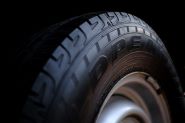How to drive safely on icy roads
Driving on icy roads can be daunting, and potentially dangerous. Here are some tips to help you stay safe on the roads in icy conditions:

1. Check your tyres
Your tyres do a pretty important job of keeping you safe when it’s icy out; they’re the only part of your car that ever touches the road, so they’re responsible for keeping a good grip. Old, worn, or damaged tyres will have less grip, meaning you’re more likely to slip on any patches of ice.
Your first check should be your tread – that’s what physically grips the road, so you’ll want to make sure you’ve got a safe (and legal) tread depth. The legal limit is 1.6mm, but most manufacturers will recommend you change them before they drop below 3mm to make sure you don’t lose too much traction. You’ll also want to check for any physical wear or bulging – damaged tyres leave you at risk of a blowout mid-journey and will be even more risky on icy roads.
If your tread is getting low, or you notice some physical damage, you should replace your tyres ahead of winter weather. Short on time? We offer same-day tyre fitting at a range of our garages, to get you moving safely again in no time.
Shop tyres
If you’re not sure about the condition of your tyres, or just want the reassurance of a second opinion, pop to your local National for a Free Tyre Check. We’ll check your tread depth, pressure, and any signs of damage.
Book a Free Tyre Check
2. Slow down
As for your driving, the most important thing to remember is to slow down. There’s nothing wrong with being cautious, especially since slick and slippery roads can make it difficult to keep control of your vehicle. Reducing your speed will not only help to stop you slipping, but you’ll have more time to spot any potential hazards too. The sooner you see an issue, the less harshly you have to brake and the less chance there is of you sliding.
3. Leave more room ahead of you
Since ice can make it harder for your car to stop, you’ll want to leave more space between you and the car in front. You should always leave enough room to be able to stop in plenty of time, but icy roads will increase your stopping distances. So, leaving a little extra space will give you more time to react if the car in front of you has to slap the brakes on.
4. Brake and accelerate with caution
Speaking of slapping the brakes on, that’s generally a bad idea on a slick surface. Sudden or hard braking on icy roads can cause your vehicle to skid or spin out of control. So instead, gently pump the brakes to gradually slow down. In the same way, hasty steering or acceleration can also cause your vehicle to lose traction. Make smooth and gradual movements when steering, accelerating, and braking to avoid losing control of your car.
5. Use your low beams
As well as slowing down and leaving more room, using your low beams can also help you see and be seen when the roads are icy. Low beams provide a more focused and directed light, which can help you see any potential hazards on the road. They also make it easier for other drivers to see you, which can help prevent any accidents.
6. Avoid using cruise control
While incredibly handy on dry roads, cruise control can be a bad idea when it’s icy (or even just rainy out). Cruise control is designed to keep you at a set speed, right? So, it’ll adjust how much it’s ‘pressing the accelerator’ depending on the road conditions, like reducing the acceleration on a slope or upping it on a hill to maintain the same speed. If you start to lose grip on an icy road, the cruise control will continue to accelerate and speed up the spin, making it harder to regain control.
Winter and All-Season Tyres
At National, we stock a wide range of both winter tyres and?all-season tyres, no matter your budget. To find the perfect tyres for your vehicle, just pop your vehicle registration or tyre size into the section at the top of this page, then w filter by either?winter tyres?or all-season tyres. For some more general advice on handling the roads over the colder months, check out our Winter Driving Tips blog.
Did you enjoy this blog post? |108 people found this review helpful



 Sign up for SPECIAL OFFERS
Sign up for SPECIAL OFFERS
